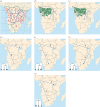Genetic variation reveals large-scale population expansion and migration during the expansion of Bantu-speaking peoples
- PMID: 25209939
- PMCID: PMC4173682
- DOI: 10.1098/rspb.2014.1448
Genetic variation reveals large-scale population expansion and migration during the expansion of Bantu-speaking peoples
Abstract
The majority of sub-Saharan Africans today speak a number of closely related languages collectively referred to as 'Bantu' languages. The current distribution of Bantu-speaking populations has been found to largely be a consequence of the movement of people rather than a diffusion of language alone. Linguistic and single marker genetic studies have generated various hypotheses regarding the timing and the routes of the Bantu expansion, but these hypotheses have not been thoroughly investigated. In this study, we re-analysed microsatellite markers typed for large number of African populations that-owing to their fast mutation rates-capture signatures of recent population history. We confirm the spread of west African people across most of sub-Saharan Africa and estimated the expansion of Bantu-speaking groups, using a Bayesian approach, to around 5600 years ago. We tested four different divergence models for Bantu-speaking populations with a distribution comprising three geographical regions in Africa. We found that the most likely model for the movement of the eastern branch of Bantu-speakers involves migration of Bantu-speaking groups to the east followed by migration to the south. This model, however, is only marginally more likely than other models, which might indicate direct movement from the west and/or significant gene flow with the western Branch of Bantu-speakers. Our study use multi-loci genetic data to explicitly investigate the timing and mode of the Bantu expansion and it demonstrates that west African groups rapidly expanded both in numbers and over a large geographical area, affirming the fact that the Bantu expansion was one of the most dramatic demographic events in human history.
Keywords: Africa; Bantu-speakers; approximate Bayesian computation; migration; population expansion.
Figures





References
-
- Scarre C. 2009. The human past. World prehistory and the development of human societies. London, UK: Thames and Hudson.
-
- Phillipson D. 2005. African archaeology. Cambridge, UK: Cambridge University Press.
-
- Vansina J. 1995. New linguistic evidence and the Bantu expansion. J. Afr. Hist. 36, 173–195. (10.1017/S0021853700034101) - DOI
-
- Pakendorf B, Bostoen K, de Filippo C. 2011. Molecular perspectives on the Bantu expansion: a synthesis. Lang. Dyn. Change 1, 50–88. (10.1163/221058211X570349) - DOI
-
- Bleek WHI. 1862. A comparative grammar of South African languages. Part I. Phonology. London, UK: Trübner & Co.
Publication types
MeSH terms
LinkOut - more resources
Full Text Sources
Other Literature Sources

